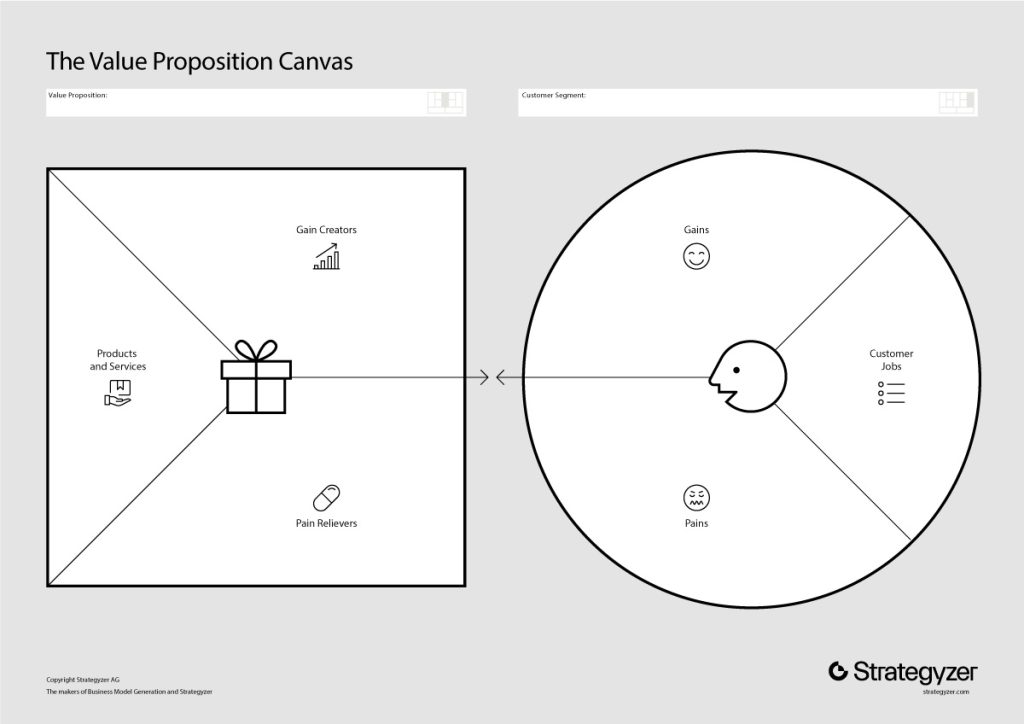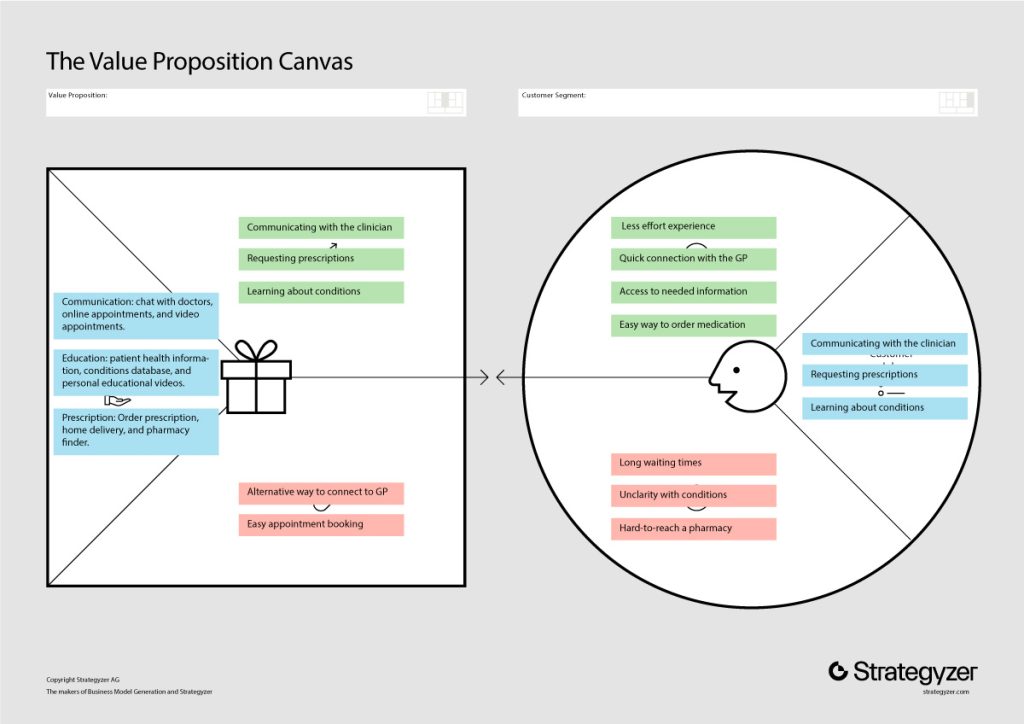Applying the Value Proposition Canvas in Healthcare Technology
When I teach design to my students, I usually tell them to look for the “value” and acknowledge it is the most important connection between you and your user. The core point is to address their needs, solve their problems and achieve innovation. If we apply tools such as the Double Diamond Design Thinking or solve a problem using root cause tools such as 5 Whys, Fishbone Diagram, TRIZ, SCAMPER Technique and 8D Problem Solving, we are looking for the value our solution can provide the user. To this goal, one of the tools that can significantly help identify this value is the Value Proposition Canvas, which we can apply in health technology to focus on the core relationship between your patients and the delivered technology.
A clear understanding of patients’ needs is crucial when designing health technology. These needs are addressed through the value provided by delivering the healthcare solution. However, this value can be easily lost in the middle of complex parameters involved in healthcare technology design. This article focuses on the application of the value proposition canvas in the healthcare context by providing examples from different companies’ practices.
What is the Value Proposition Canvas?
The Value Proposition Canvas is a tool that allows designers to focus on patients’ needs (gains and pains) and address these needs through gain creators and pain relievers. The tool was coined by Strategyzer and its founder, Alex Osterwalder. While the tool is widely applied in the business domain, it can be used in various industries because of its generic structure. The Value Proposition Canvas can be applied in multiple industries as the main focus is the same target of any provided products or services.
While the tool is linked to his primary tool, the Business Model Canvas, it eliminates other business distractions. It focuses only on the value added to the health product or service. The gains and the pains of the target patient drive this value. The word “pain” here refers to the problems they need to solve to improve their experience when dealing with health technology, using health services or taking their prescribed treatments. (Also check Using Value Stream Maps to Improve User Experience)
The canvas value proposition itself is that it provides a visualised tool to summarise and highlight the key elements of the patient’s needs and how to address these needs in the provided health technology solution, which makes the process of linking between the solution features and patients’ needs clear, visualised, and effective.
Align with the definition of the Value Proposition Canvas, we need to ask ourselves, what is the value proposition? The value proposition is the unique feature or group of features in the product or service that address consumers’ (in this case, patients’) needs and expectations. Accurate addressing patients’ empathic needs and differentiating the offering from alternative solutions provides an opportunity for health technology to succeed in the market.
What are the Components of the Value Proposition Canvas?
As highlighted, the Value Proposition Canvas focuses on added value. Therefore, it is divided into two main parts: the consumer profile (patient) on the right side, presented as a circle, and the value proposition (product or service), which is presented as a square.
The Patient Profile
Since we focus on patients, I will call it the patient profile or patient persona. The right part of the canvas focused on patients from three main areas:
Patient Job
This part includes the different tasks, jobs, and problems patients face. This job includes taking medication, managing health, monitoring Insulin injections, and dealing with anxiety. It can also reflect access to services such as the A&E waiting area or easy access to GP appointments.
The Job section reflects the underlying aim that pushes the patient’s needs and formulates that solution to be delivered considering all the social, functional, and emotional needs.
The Pains
As with any of the above examples, problems and expectations are always associated. Two sides to the coin: the patient’s problem needs to be solved, and the expectation to deliver. The Pains section reflects the problems that patients face while trying to accomplish the job. These problems can be frustration, negative feelings, and bad usability. In the healthcare systems, various Pain points face patients, such as Long waiting times and the inability to access GPs and treatments. While health technology can help address these problems, solution platforms can include pain points such as bad user experience, missing features or the lack of focus on emotional needs while addressing physiological needs. Example questions to enquire regarding patients’s paint points are:
- What are the patients’ bad experience characteristics?
- Why are patients not happy with the current health service?
- In which part of the health service do patients suffer the bad experience?
- We can explore the patients’ pain points throughout their experience using tools such as the consumer journey map, which allows us to
GE Health identified the pain point when children are afraid of X ray and MRI rooms. So, they worked with Disney to provide a pleasant experience for children as shown in the video above.
The Gains
In contrast, the Gains refer to the patient’s expectations and what they expect from the healthcare service or technology. Patients’ experience must be considered similarly to the medical requirements in a new healthcare system paradigm. An imbalance between patients’ medical and experience requirements is one of the main causes of the current catastrophic problems in the healthcare system. Some of the questions that can be asked here are:
- What do patients want to have in the health app?
- What are the features to embed to improve patient experience?
- What are the unmet needs that can add value to the health technology?
While both pains and gain are two sides of one coin, they may overlap. However, gains can be like wishes and expectations not linked to existing suffering or pain. Examples of Gains can be easy access to health data and socialise with health app users who have similar conditions.

The Value Creation Map
The left section of the Value Proposition Canvas is the value map where the company or the healthcare system addresses the patients’ Gains and Pains. It presents the action needed to address them and the final health technology or application that presents the final value for patients.
Pain Relievers
Pain relievers target the necessary needs patients should use the health technology for. These pain relievers present the core features of the health technology that it can’t have an accurate value without it and can’t compete with other rivals. For example, monitoring weight in weight management mhealth applications. The patient’s pain is the lack of ability to remember their weight progress and how they progress in their weight programme. While developing features to address patients’ pain, the main question is what solutions the health technology can provide to eliminate patients’ pain points.
Gain Creators
The Gain Creators present the features added to the health technology to meet the patient’s needs. These needs can be known by patients and defined when trying to investigate what are the Gain points. However, there are other aspects known as unmet unidentified needs. These needs that patients only know are met once they see it in the delivered solution. The unmet needs require thoughtful research that allows designers to put themselves in their patient’s shoes and see their experience from the perspective of the situation’s complexity.
- How to improve a patient’s social experience when using the application?
- How do we help patients to adhere to the prescribed interventions?
Think about pains and gains as the inner and outer circle of value. While pain relievers represent the inner core circle, gain creators present the extended value or the outer circle.
Products and Services
The final part of the Value Proposition Canvas is the product or service that will include pain relievers and gain creators to help patients do the required task. Sometimes, the pains and gains become too many to fit into one product; otherwise, it will be complex.

This problem can be solved in physical products by having different overhangs or products that target the same pain points but differentiate in terms of the gain creators, such as the CPAP machines. While all the products share the same core feature to improve sleep for patients with sleep apnea, other added features include different types of masks and extensions for water tanks to provide humidification.
Example of Applying Value Proposition Canvas in Health Technology
In this case study, a general practice (GP) clinic would like to improve its service through a health mobile application. To achieve this goal, the GP needs to understand patients’ pain points and desired functions that can eliminate them.
The patients’ job can be communicating with the clinician, requesting prescriptions, and learning about conditions. Through the patients’ experience in achieving these goals, they face pains and gains. Examples of the pains include:
- Long waiting times.
- Unclarity with their conditions.
- Ordering prescriptions (or hard-to-reach a nearby pharmacy).
In contrast, the gains can be a less effort experience, quick connection with the GP, easy access to needed information, and an easy way to order medication.

On the left side of the Value Proposition Canvas, we focus on the reactions to patient pains and gains, which can be reflected in the application. For example, pain relief can be providing an alternative way to connect to the GP and an easy appointment booking system. The gain creators can offer an educational element for patients to learn about their conditions and easy access to medication.
Based on the above, the product can include several features that respond to this mapping, such as:
- Communication: chat with doctors, online appointments, and video appointments.
- Education: patient health information, conditions database, and personal educational videos.
- Prescription: Order prescription, home delivery, and pharmacy finder.

The value proposition canvas can help us bridge between pains and gains and structure the health technology solution around the core value that addresses patients’ needs and improves their experience. Furthermore, the target product or feature focuses the outcome around this value without being distracted by other unnecessary features or applications. This lesson is learned from several examples, such as the Apple case study. The centralisation of health technology around value for patients can improve patients’ experience, drive healthcare innovation, and reduce the burden facing different healthcare systems worldwide.






